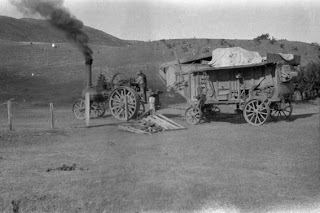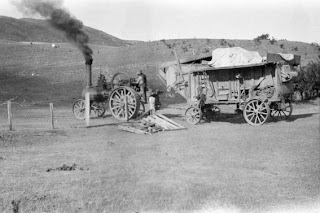I've used the Pentax 645 for a couple of weeks now - long enough to put through several rolls of film. I've been using Fuji slide film for the most part, but have also started to put through some Agfa Optima colour negative as well.
There's no lab where I live that can process 120 E-6, so I have had to send it to the nearest city (Christchurch) and have them courier the developed and sleeved film back to me. Adds another few days to the whole process, but that's the 'joy' of working with film again - it certainly isn't immediate.
Long story short - I've really enjoyed using the Pentax 645 and I'm glad I've got it. No, it won't replace my existing digital kit - which I also still love - but it certainly forces me to shoot differently, which I like. Anyway, I sent my first four rolls of 120 away recently and they arrived back yesterday. So what did they turn out like?

Not bad really. I'm very happy with the 645 format for shooting, and the image it produces is certainly large enough for my purposes. One thing I've 're-learnt' by looking over the slides is that I need to bracket my exposures more often. I basically relied on the Pentax's built in meter for everything, and it's probably .5 to 1 stop 'under' exposing almost every frame. Must remember to bracket!
Having said that, I'm very pleased with the colours (although that has a lot to do with the lovely Fuji slide film), both lenses look sharp and contrasty, and the detail from the medium format image is worth the price of admission alone. And before I forget - all the images here are basically being shown full-frame, with perhaps a slight cropping when a horizon needs to be levelled in Photoshop.

Above is an image that I have also taken a lot using digital cameras - one of my favourite spots to go and 'test' gear from. This was taken using the 150mm lens, and again no complaints about colour, contrast or sharpness. The colours here are pretty much straight from camera, with a little sharpening applied due to scanning for the web.
While we're on the subject of scanning, it may pay to outline my scanning workflow, because this is where I believe the medium format slide comes into its own.
These images have been reduced for web purposes (obviously), but the beauty of scanning medium format is that you can set your own dpi (dots per inch), depending of course, on what your scanner can go up to. What do I mean by this?
Well, if you take digital cameras, they are 'measured' in 'mega' pixels - that is 'million' pixels, depending on the size of image sensor they use. If, for example, you have a camera with a sensor that captures 3000 pixels across by 2000 pixels down, then you have a 6 megapixel camera - it's capable of capturing 6 million pixels. That's pretty common. Now if you take that file, and print it out at a 'hi-resolution' of 300dpi (300 dots per inch is seen by the human eye as continuous tone), you will get a print slightly smaller than A4 - about an 8x10 inch print (give or take). Not bad, and cetainly about as big as many people want to print.
But what say you want to print bigger? Well then you have to 'increase' the size of the file - either by making each pixel larger, or by 'adding' extra pixels to expand the image beyond what it's optimal printing size should be. You can get away with this - up to a point. But it isn't long before things start to look decidedly dodgy and you get that classic 'digital' pixelated look to your enlarged image. So with any digital camera, you are constrained with enlargements by the megapixel rating your sensor has. And as with the case of most things, bigger means better.

As a landscape photographer, I want to print my work big - as big as I can. So following what I've outlined above I will need to go for a camera with as many megapixels as I can lay my hands on. Right? Well yeah - problem is those camera cost a small fortune and I'm kinda lacking in the fortune department. But there is another way...
With my medium format slide, I can scan it to whatever dpi I desire - up to 12800 (as much as my Epson scanner goes up to). So, for example, the originals of the images shown here were scanned at 3200dpi. This took a speedy 4 minutes each, and resulted in a 100MB file! That's 6894 x 5111 pixels with a final optimal print size of 58 x 43cms at 300dpi. The equivalent of a 35.2 megapixel camera!!! Do you know how much it would cost me for a 35.2 megapixel camera - if they made them! Pentax is rumoured to be producing a digital 645 that will use a 31 megapixel chip - but it will cost an arm and a leg (when and if it eventually comes out), and I'm quite partial to my arms and legs thank you very much.
My Epson V700 is a professional flatbed scanner - with image quality approaching that of drum scanning (the very best scanning devices) - and it wasn't cheap. But still, if you factor in a top of the line scanner and shoot medium format you are still coming out smelling of roses, and kick digital butt in the megapixel file stakes.
I was curious, and wanted to know what 12800 dpi did for a file. So I scanned one at that resolution as well. The resulting image took 35minutes to scan, and then another 10 minutes to load into Photoshop. Boy, with times like this you just 'know' it's gonna be a big file. And I wasn't disappointed. Scanning a 645 slide at 12800dpi gives you a 1.6 Gigabyte file. That's right ladies and gentlemen - GIGABYTE file. Not megabyte - Gigabyte! That's 27815 x 20453 pixels - a 2.3 x 1.7 metre print at 300dpi! Unbelievable. I tried to calculate how many megapixels that was and my calculator exploded. It literally didn't have enough spaces for it. Even I don't need to print that big. But I 'could'. With film.
Think about it.

And finally - (sorry for the extra long post) - I've already started adding to my medium format kit. I managed to pick up a dedicated Pentax AF280T flash and had to give it a whirl. I'm very happy, and a little surprised, at the excellent results I got using it in full auto mode. The above test shot of my wife (thanks honey, I won't show it to anyone, honest), was taken in very low light, but has turned out perfectly. The light was so low, in fact, that I had trouble focusing. But I bounced the flash off the ceiling, and it has hit the exposure bang on. Impressive.
Is shooting medium format film for everyone? No, I'm not suggesting that it is. But maybe it has digital advantages - over digital? Maybe it's not the tired old dinosaur the camera industry would have you believe it is? Maybe.













































